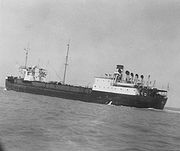
Lake tanker
Encyclopedia

Lake Maracaibo
Lake Maracaibo is a large brackish bay in Venezuela at . It is connected to the Gulf of Venezuela by Tablazo Strait at the northern end, and fed by numerous rivers, the largest being the Catatumbo. It is commonly considered a lake rather than a bay or lagoon, and at 13,210 km² it would be the...
in Venezuela
Venezuela
Venezuela , officially called the Bolivarian Republic of Venezuela , is a tropical country on the northern coast of South America. It borders Colombia to the west, Guyana to the east, and Brazil to the south...
, to the three off-shore refineries located on the Dutch islands of Aruba
Aruba
Aruba is a 33 km-long island of the Lesser Antilles in the southern Caribbean Sea, located 27 km north of the coast of Venezuela and 130 km east of Guajira Peninsula...
and Curaçao
Curaçao
Curaçao is an island in the southern Caribbean Sea, off the Venezuelan coast. The Country of Curaçao , which includes the main island plus the small, uninhabited island of Klein Curaçao , is a constituent country of the Kingdom of the Netherlands...
. The entire operation of these refineries depended on the crude from Lake Maracaibo, and a fleet of these little tankers carried the crude from Lake Maracaibo, through the shallow cannel between Lake Maracaibo and the Caribbean Sea
Caribbean Sea
The Caribbean Sea is a sea of the Atlantic Ocean located in the tropics of the Western hemisphere. It is bounded by Mexico and Central America to the west and southwest, to the north by the Greater Antilles, and to the east by the Lesser Antilles....
, to Aruba and Curaçao, Netherlands West Indies. Aruba had two refineries, Lago Oil & Transport Co. Ltd.
Lago Oil & Transport Co. Ltd.
Lago Oil & Transport Co. Ltd. had its beginning in 1924 as a shipping company carrying crude oil from Lake Maracaibo to its transshipment facility on the island of Aruba.-History:...
, owned by Standard Oil of New Jersey and Eagle, owned by Royal Dutch Shell
Royal Dutch Shell
Royal Dutch Shell plc , commonly known as Shell, is a global oil and gas company headquartered in The Hague, Netherlands and with its registered office in London, United Kingdom. It is the fifth-largest company in the world according to a composite measure by Forbes magazine and one of the six...
. There was also a Royal Dutch Shell refinery on the island of Curaçao. All three refineries depended on their own fleet of Lake tankers to supply the crude for the refinery.
The Lago refinery housed the officers and their families in Lago Colony
Lago Colony
Lago Colony was a community located on the east end of the island of Aruba, in the area presently known as Seroe Colorado. This town consisted of about 700 homes, a hospital, club house, bowing alley, and an American School, with first through twelfth grades and approximately 180 students...
, a community owned by the company which housed all their foreign staff employees.
The Lake Tanker was a small vessel in comparison with the larger ocean going oil tankers; they have a very shallow draft with a flat bottom. This allowed this small ship to maneuver over the ever shifting sand bars that blocked the channel going into Lake Maracaibo. This shallow entrance into Lake Maracaibo from the Caribbean Sea prevented larger ships from entering the lake and thus the need for the smaller Lake Tanker.
The first Lake Tankers were built in England in around 1923 and subsequent ships remained small until after World War II when, with the dredging of the channel to Lake Maracaibo the lake tankers became larger. The last Lake Tanker was retired from service in 1953, when the cannel from Lake Maracaibo to the sea was finely dredged and deepened to allow ocean-going tankers to enter the lake and pipelines from the lake were constructed to deep water ports in the Paraguana Peninsula
Paraguaná Peninsula
The Paraguaná Peninsula is a peninsula in Venezuela, situated in the north of Falcón State. The island of Aruba lies 27 km to the north. Bonaire and Curaçao are slightly further away. The Paraguaná Peninsula is connected to the rest of the state by a natural isthmus of Médanos. The Peninsula...
.

